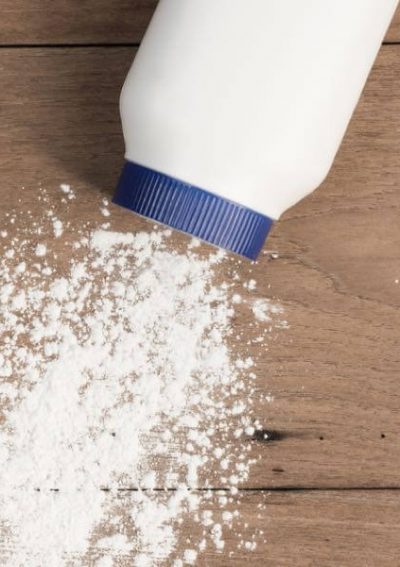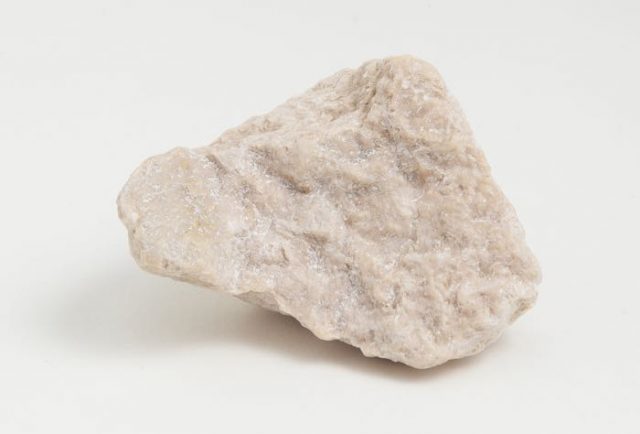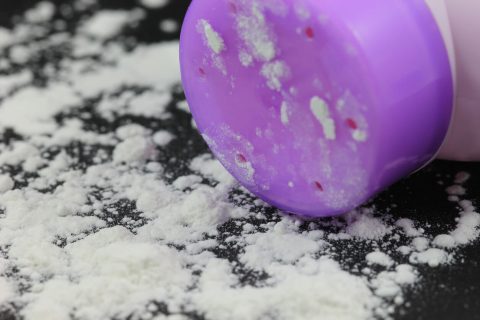Talcum Powder
Talc is a soft mineral widely used in personal care and cosmetic products. Still, concerns over potential asbestos contamination and links to cancer have raised safety questions, prompting many people to choose talc-free alternatives.

What Is Talc?
Talc is a natural mineral that contains magnesium and a small amount of water combined with silica and oxygen. After talc is mined from the earth, it’s crushed and refined into a fine powder.
Because it’s soft and smooth and retains fragrance, talc can be a helpful ingredient in baby powder and many cosmetics. Until 2023, it was the primary ingredient in Johnson & Johnson’s Baby Powder.
Unfortunately, talc deposits are often located alongside asbestos in the earth, so talc is sometimes contaminated with the cancer-causing agent. Over the years, some tests have turned up trace amounts of asbestos in baby powder and other personal care products containing talc.

What Products Contain Talc?
While baby powder is probably the best-known talc product, talc is also a common ingredient in many cosmetics, such as eyeshadow and face powders.
Talc is added to makeup to absorb moisture and provide a soft, silky texture so it spreads more quickly. It also prevents caking and gives makeup its opaque finish. Talc is also common in deodorants, dry shampoos and other personal care products.
Talc is also used in pharmaceuticals and various food products, including chewing gum, candy and rice.
In the industrial world, Talc can be found in everything from asphalt shingles to caulks, sealants, paint and more.
Talc Regulation
The Food and Drug Administration does not perform safety testing on talc or talc-containing products before they hit store shelves, and it hasn’t set limits on asbestos in cosmetic talc.
The Cosmetic Ingredient Review (CIR) panel plays a significant role in the self-regulation of the cosmetics industry, including the oversight of talc-containing products. The CIR panel is an industry-funded program that operates independently from the U.S. Food and Drug Administration, but with some FDA involvement. In effect, the cosmetic manufacturers police themselves.
That said, the FDA monitors potential safety problems with cosmetics, including talc products, and can intervene if necessary. The agency examined cosmetic products containing minerals purchased in retail stores. In 2022 and 2023, the FDA selected several talc-containing cosmetic products for testing based on wide-ranging benchmarks.
- Product type
- Price
- Popularity on social media
- Marketing that targeted children and women of color
- Reports of possible asbestos contamination
The FDA purchased the samples, kept them anonymous and sent them to a private lab for analysis.
Is Talcum Powder Safe for Babies?
Though baby products are generally safe for infants and children, talcum-based baby powder can be hazardous. Dusting an infant or child with talc can create large clouds of powder that pose a danger. Infants can accidentally inhale talc dust and end up with severe breathing difficulties and other serious problems.
Most pediatricians recommend not using baby powder on your children to avoid these risks.
Common respiratory symptoms of talcum powder poisoning include chest pain, coughing, trouble breathing, wheezing and rapid or shallow breathing.
Other symptoms of talc poisoning
- Decreased urine output
- Eye and throat irritation
- Low blood pressure or cardiovascular collapse
- Drowsiness
- Weakness
- Twitching of the arms, legs or face
- Seizures
- Coma
- Blisters
- Bluish skin, lips and fingernails
- Diarrhea and vomiting
Although rare, there have been reports of children dying from talc inhalation. If your child shows any signs or symptoms of talc poisoning, move them to fresh air and seek emergency medical attention. You can reach the National Poison Help hotline at 1-800-222-1222.
How to Protect Your Baby
- Use a cornstarch-based powder or other alternative instead of talcum powder.
- Always keep baby powder out of reach of children.
- Keep powder away from your child’s face to avoid inhalation.
Cancer and Other Health Concerns
In July 2024, the World Health Organization’s International Agency for Research on Cancer (IARC) published a report stating that talc is “probably carcinogenic in humans” — meaning it probably causes cancer. This finding supported a significant study from May 2024, which found that intimate care products containing talc were linked to an increased likelihood of developing ovarian cancer.
The IARC’s finding is based on several factors. While there is limited evidence connecting talc use to ovarian cancer in people, there is enough evidence from studies on animals to raise concerns. Furthermore, strong scientific evidence suggests that talc can harm human cells.
While the links between talc and ovarian cancer are a subject of intense debate, thousands of women with ovarian cancer have filed lawsuits against Johnson & Johnson and other companies. Some talcum powder lawsuits have resulted in record verdicts.
Faced with thousands of baby powder lawsuits and a drop in sales, Johnson & Johnson announced in August 2022 that it would discontinue its iconic talc-based baby powder globally in 2023. The company insists that the decision is purely financial and that its talc-based baby powder doesn’t contain asbestos or cause cancer.
Talcosis Risk from Breathing in Talcum Powder
Another health risk related to talc inhalation is pulmonary talcosis, a severe type of lung inflammation. The disease was first recognized decades ago among workers in the talc mining industry who were exposed to large amounts of the mineral for extended periods.
Case reports in medical literature reveal that chronic inhalation of cosmetic talc, such as baby powder, can also cause talcosis.
A 2018 case report in the Journal of the Belgian Society of Radiology, for instance, described a 31-year-old woman who developed talcosis after using an abundant amount of cosmetic talc daily for several years. The woman’s primary symptoms were shortness of breath and joint pain. A CT scan showed multiple abnormal growths and evidence of inflammatory changes in her lungs.
Symptoms of talcosis may vary widely. While some people have no symptoms at all, others experience respiratory failure. Common symptoms may include dyspnea, a shortness of breath that worsens over time, or a chronic cough.
Unfortunately, diagnosis isn’t always immediate. According to medical reports, full-blown talcosis sometimes takes years to develop.
A 2011 case report in The BMJ describes a woman who developed talcosis 10 years after using and inhaling cosmetic talcum powder for four months. According to the report’s authors, the potential lag time between the exposure and diagnosis causes many cases of talcosis to be misdiagnosed.
Should I Avoid Using Baby Powder?
While the U.S. National Toxicology Program has not completed its review of cosmetic talc as a possible carcinogen, other countries are considering stricter mineral regulations.
The Canadian government is considering adding the mineral to a list of toxic substances, warning that using talc products such as baby powder on or near genitals may cause ovarian cancer.
Steps to minimize your talc exposure
- Avoid inhaling talcum powder.
- Avoid using products that contain talcum powder around the female genitals.
- Choose a talc-free alternative instead.
The American Cancer Society also recommends people concerned about using talcum powder avoid or limit their use of talc products until more information is available.
Talcum Powder Alternatives
Commercial cornstarch-based powders have a similar consistency to talc, are just as absorbent and still have that iconic baby powder scent.
Talcum powder substitutes include:
- Arrowroot
- Baking soda
- Cornstarch
- Kaolin
- Magnesium or zinc
- Tapioca
Whatever alternative you choose, you should still avoid using powder around your baby’s face.
More and more makeup manufacturers are also offering talc-free cosmetics. Omiana Cosmetics, for instance, only sells talc-free makeup. Cover FX’s line of products is free from five controversial ingredients: talc, parabens, mineral oil, fragrance and gluten.
When you’re selecting any product, be sure to read the ingredient label. If you’re unfamiliar with a product or its ingredients, you can look it up on the Environmental Working Group’s Skin Deep Cosmetics database. The database includes over 70,000 products and highlights ingredients of concern.
Editor Lindsay Donaldson contributed to this article.
24 Cited Research Articles
Consumernotice.org adheres to the highest ethical standards for content production and references only credible sources of information, including government reports, interviews with experts, highly regarded nonprofit organizations, peer-reviewed journals, court records and academic organizations. You can learn more about our dedication to relevance, accuracy and transparency by reading our editorial policy.
- U.S. Food and Drug Administration. (2024, December 26). Talc. Retrieved from https://www.fda.gov/cosmetics/cosmetic-ingredients/talc
- American Cancer Society. (2024, August 1). Talcum Powder and Cancer. Retrieved from https://www.cancer.org/cancer/cancer-causes/talcum-powder-and-cancer.html
- Stayner, L.T., et al. (2024, August). Carcinogenicity of Talc and Acrylonitrile. Retrieved from https://www.thelancet.com/journals/lanonc/article/PIIS1470-2045(24)00384-X/abstract
- International Agency for Research on Cancer. (2024, July 5). IARC Monographs Evaluate the Carcinogenicity of Talc and Acrylonitrile; IARC Monographs Volume 136. Retrieved from https://www.iarc.who.int/wp-content/uploads/2024/07/pr352_E.pdf
- O’brien, K.M., et al. (2024, May 15). Intimate Care Products and Incidence of Hormone-Related Cancers: A Quantitative Bias Analysis. Retrieved from https://ascopubs.org/doi/abs/10.1200/JCO.23.02037?journalCode=jco
- U.S. National Library of Medicine. (2023, November 2). Talcum Powder Poisoning. Retrieved from https://medlineplus.gov/ency/article/002719.htm
- Johnson & Johnson. (2022, August 11). Johnson & Johnson Consumer Health to Transition Global Baby Powder Portfolio to Cornstarch. Retrieved from https://www.jnj.com/johnson-johnson-consumer-health-to-transition-global-baby-powder-portfolio-to-cornstarch
- Anderson, E., et al. (2022, June 14). What’s the Risk? Talc-Based Cosmetic Products. Retrieved from https://www.canr.msu.edu/news/talc-based-cosmetic-products
- Hernandez, J. (2021, June 29). Johnson & Johnson Targeted Black Women With Products Linked to Cancer, Lawsuit Says. Retrieved from https://www.npr.org/2021/07/29/1022355144/johnson-johnson-targeted-black-women-powder-products-cancer-lawsuit
- Government of Canada. (2018, December 13). Talc: Learn About Talc and if It’s Safe. Retrieved from https://www.canada.ca/en/health-canada/services/chemicals-product-safety/talc.html
- Ubelacker, S. (2018, December 5). Talcum Powder Could Pose Danger to Lungs and Ovaries, Health Canada Warns. Retrieved from https://www.cbc.ca/news/health/talcum-powder-may-be-harmful-to-lungs-health-canada-1.4933506
- U.S. Food and Drug Administration. (2018, September 5). Nakissa Safreih, Ph.d. (2017). Retrieved from https://www.fda.gov/about-fda/commissioners-fellowship-program/nakissa-sadrieh-phd-2017
- Verlynde, G., et al. (2018). Pulmonary Talcosis Due to Daily Inhalation of Talc Powder. Retrieved from https://www.jbsr.be/articles/10.5334/jbsr.1384/
- The Associated Press. (2017, May 5). Woman Awarded Record $110m in Baby Powder Lawsuit. Retrieved from https://www.thestar.com/business/2017/05/05/woman-awarded-record-110m-in-baby-powder-lawsuit.html
- What’s New in Food Technology Manufacturing. (2015, September 30). Talc Use in Food Processing a Health Hazard, Say Researchers. Retrieved from https://www.foodprocessing.com.au/content/food-design-research/news/talc-use-in-food-processing-a-health-hazard-say-researchers-859641872
- Devasahayam, J., Pillai, U. & Lacasse, A. (2011, July 15). Talcum Powder Pica as the Cause of Interstitial Lung Disease. Retrieved from https://academic.oup.com/qjmed/article/105/8/795/1563653
- Shakoor, A. et al. (2011). Pulmonary Talcosis 10 Years After Brief Teenage Exposure to Cosmetic Talcum Powder. Retrieved from https://www.ncbi.nlm.nih.gov/pmc/articles/PMC3185388/
- Van Huisstede, A. et al. (2010). Talcosis Due to Abundant Use of Cosmetic Talcum Powder. Retrieved from https://err.ersjournals.com/content/19/116/165
- Mofenson, H.C. et al. (1981, August). Baby Powder—A Hazard! Retrieved from https://pediatrics.aappublications.org/content/68/2/265
- Environmental Protection Agency. (n.d.). 11.26 Talc Processing. Retrieved from https://www3.epa.gov/ttnchie1/ap42/ch11/final/c11s26.pdf
- Environmental Working Group. (n.d.). Talc. Retrieved from https://www.ewg.org/skindeep/ingredients/706427-TALC/
- Herb & Root. (n.d.). What to Use Instead of Talcum Powder- the Top Alternatives to Talc. Retrieved from https://herbandroot.com/blogs/all-about-powders/what-to-use-instead-of-talcum-powder
- Mount Sinai. (n.d.). Talcum Powder Poisoning. Retrieved from https://www.mountsinai.org/health-library/poison/talcum-powder-poisoning
- The Pubs Warehouse. (n.d.). U.S. Geological Survey. Industrial Minerals of the United States: U.S. Talc — Baby Powder and Much More. Retrieved from https://pubs.usgs.gov/fs/fs-0065-00/fs-0065-00textonly.pdf
Calling this number connects you with a Consumer Notice, LLC representative. We will direct you to one of our trusted legal partners for a free case review.
Consumer Notice, LLC's trusted legal partners support the organization's mission to keep people safe from dangerous drugs and medical devices. For more information, visit our partners page.
855-613-6647

